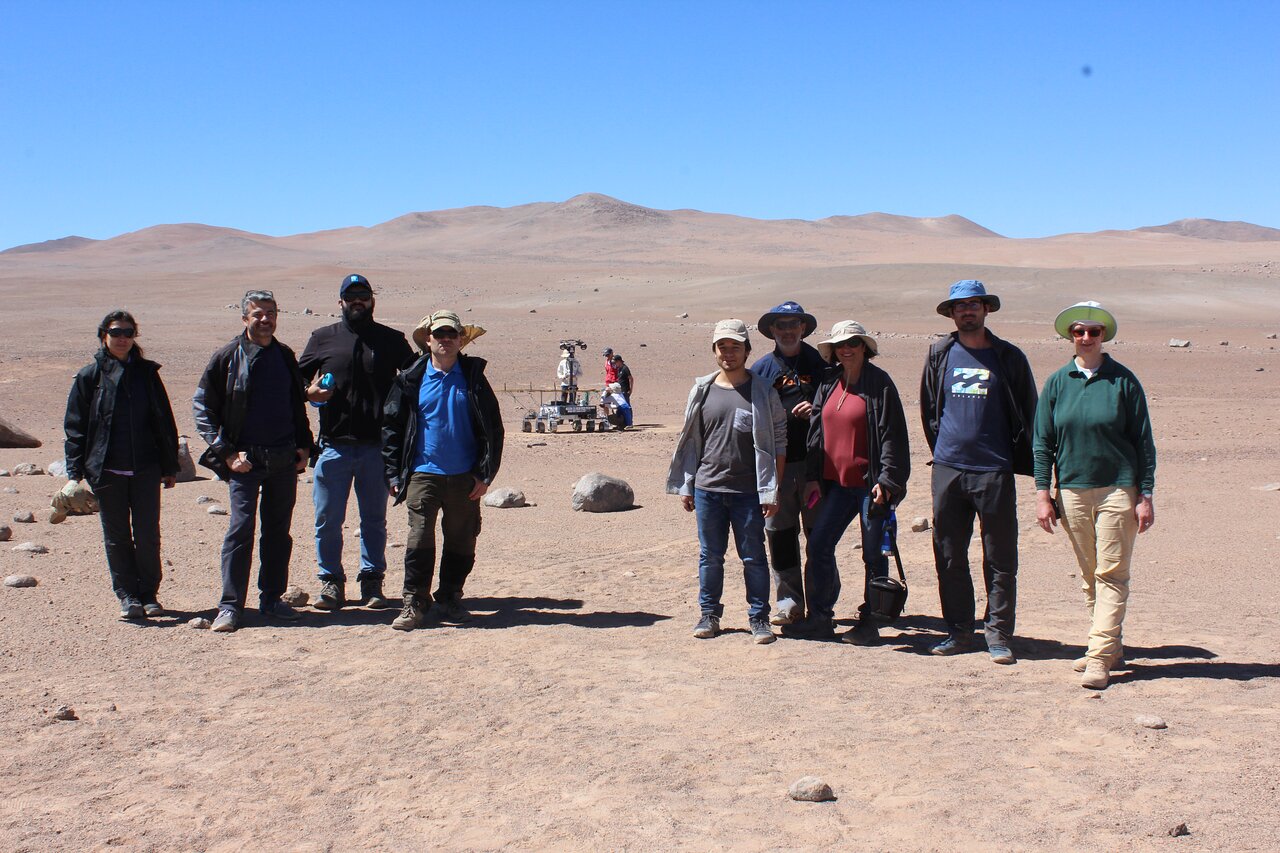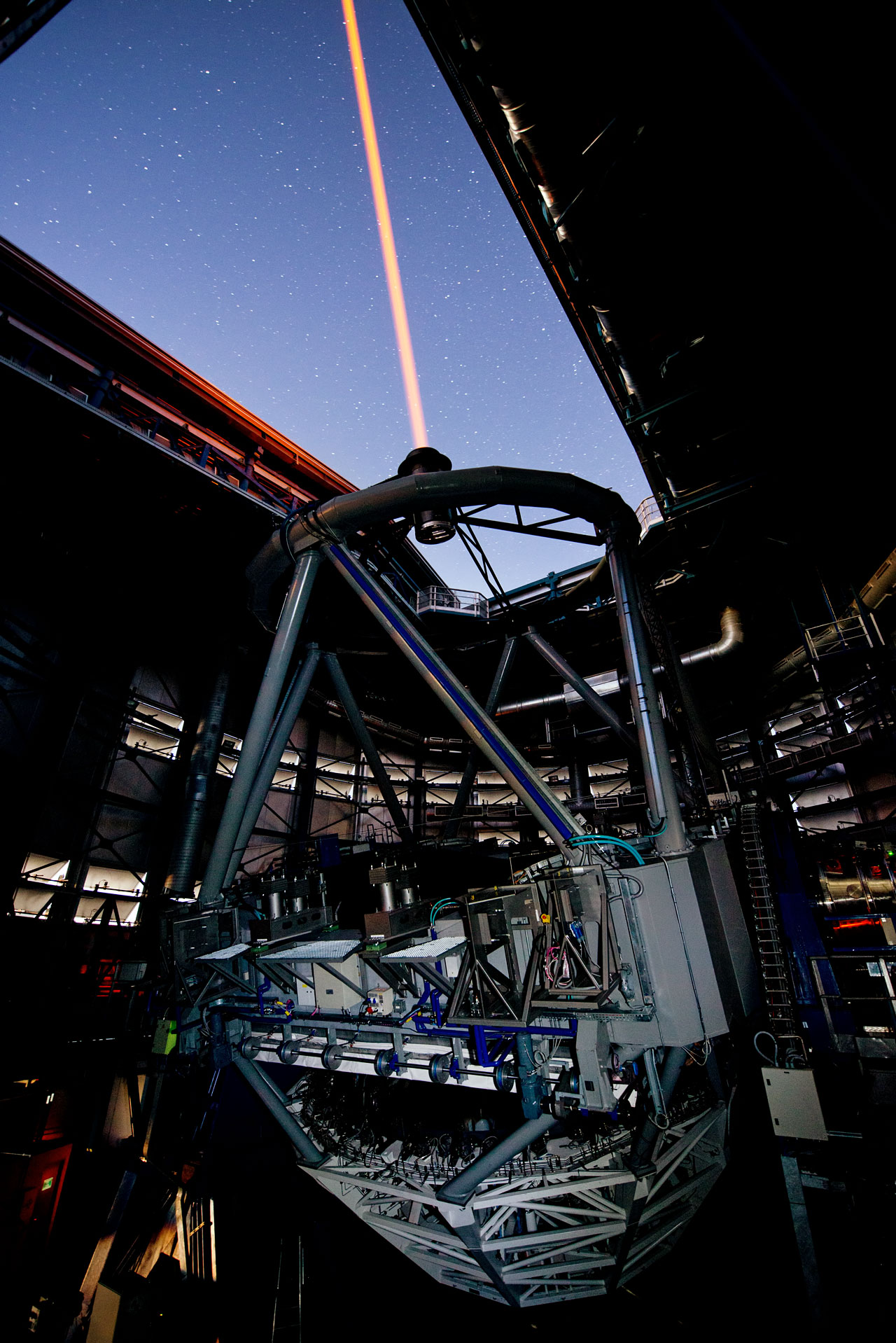- The day-to-day operations of the instrumentation group at Paranal
- The joy of following your longings and dreams
- That some people at Paranal actually do like clouds
ESO’s Paranal Observatory in Chile’s Atacama Desert is not only home to large telescopes, but also the many instruments attached to them, each with its own unique scientific purpose. We spoke to Eva Diaz, Head of Instrumentation at Paranal, about the importance of working as a team to solve never-before-encountered problems. Find out how she supports ESO in this blog post.
Eva Diaz likes the instruments she works with. These are not the instruments you would play music on, but rather the ones astronomers use to unravel the Universe’s secrets. Astronomical instruments are used to get as much data as possible from the incoming light collected by the telescopes: recording images, splitting light up in its components in a spectrograph, or even combining the light from many telescopes in an interferometer. Many such instruments exist at Paranal, with a plethora of different uses, and Eva leads a team of engineers that ensures these instruments work as they should. But where does this fascination for instruments come from?
Forging a new path
Let’s go back to the beginning. After finishing her undergraduate studies, Eva went to the Polytechnic University in Madrid, Spain, to study aeronautical engineering, and that’s where the path to scientific instrumentation was literally decided by chance: “I went with a friend, and they told us ‘we have one position at the military program and one at the scientific program, and you have to decide who is going to which’. So we tossed a coin, and I ended up in the scientific program,” she says, smiling at the memory, saying that she found herself very happy to be in the scientific environment.
She ended up working in instrument development at the Astrobiology Centre in Madrid. Instead of the ground-based telescopes used at ESO, the focus of her work in Spain was the development of instruments for space telescopes, like components for the European Space Agency’s INTEGRAL gamma-ray telescope, and the MIRI instrument on the James Webb Space Telescope. She even worked on Mars missions!
But as the years passed, she longed for a change of environment. “When I still had my children at home, I had no opportunity to work outside of Madrid. It was very difficult. So once they got older and started university, I searched for the opportunity to go outside.”
She saw the possibility of breaking new ground in another country, and picking up the position as Head of Instrumentation at ESO’s Paranal Observatory was a great opportunity to take her life into another direction. “I think it's very difficult to reinvent yourself when you already have a set life. But I recommend it, it's very good for you.” And so she did, seven years ago, and never looked back.
“I like to work in this type of environment a lot. I like the science, engineering, the desert and the people. It has been a big change and I'm very happy.”

The everyday life at the observatory
As the Head of Instrumentation, Eva leads a group of 15 people that works in two shifts. Normally she and her deputy make sure to overlap with both shifts, such that they can meet everyone in their group. “We work eight days up at Paranal, and then have six days free”. These free days Eva usually uses to enjoy life in the Chilean capital Santiago, where she lives, or to go travelling.
The everyday activity and schedule for the instrumentation group is strictly set, and is dictated by the Sun. Every morning they have a meeting where they review the night’s team report on what happened during the night, if there have been any issues, and things that need solving. It’s up to Eva to make sure that all problems are addressed, to communicate with the incoming astronomers about which possible issues to prioritise, and to help the team to run as smoothly as possible over the day, before they hand over operations to the night team again.
When we ask her about any particular proud moments she has had as Head of the Instrumentation group, she prides herself on the harmony between group members — each of whom has diverse abilities, knowledge and experience — and how they can come together to solve never-before encountered problems.
“It is a special group because we have different disciplines: cryogenics, mechanics, electronics, optics, a bit of everything,” she says.”This is the thing that I like the most: when we have a really difficult and challenging problem that is new or we don’t understand, we have to bring everyone together, sit down and come up with ideas on what to do, and you have to discuss this within the different disciplines. And this is really nice!”

Working as a team under pressure
There is nonetheless a specific moment that she remembers very strongly, during an observing run when a visiting astronomer was on site.[1] “The adaptive optics laser, which was important for the observations, had a problem and didn’t work. We decided to not run around, but to be calm and to do things very slowly, to understand what we were doing.”
The adaptive optics laser at ESO’s VLT is key to get sharp images. The laser reaches 90 km into the sky, where it will excite sodium atoms, making them glow just like a star. With this new artificial star the turbulence of the atmosphere can be measured and corrected for by reshaping a thin mirror at millisecond speeds, a must for some observations, and a struggle if the system is not working.
With such complex systems it is not always the case that manuals cover all possible issues, and the instrumentation group sometimes have to solve problems ad hoc as they go. To fix the laser, the team had to dismount a whole piece of the mechanism. “We did it very slowly and carefully, with several people looking. And in the end, the laser did work! And this visitor was impressed with how we managed all of that, working slowly and coordinating within the team, doing all of the work in a safe way. I felt very, very good about that,” she says with pride.
Driven by the challenge
The instruments are the bread and butter of any scientific research, and underpin all of the science done at ESO. Although, when it comes to the instruments at Paranal, there isn’t one in particular she likes more than the others. She cherishes the diversity and how they can suit different users and their needs. In Eva’s own words: “We have the four unit telescopes [of the VLT] that are replicating a lot of hardware, but the instruments are all unique. So I think instrumentation is more interesting because we have more differences.”
Eva is not exaggerating, and the instruments at Paranal all have different expertise. Want to take spectra of many objects at once? Go for FLAMES. Do you instead want to study individual objects but with extremely detailed spectra? UVES and the upgraded CRIRES are your friends! Looking to catch some exoplanets? Look no further than SPHERE and ESPRESSO.
Even now, Eva and the team are preparing for the upcoming instruments 4MOST (4-metre Multi-Object Spectrograph Telescope) and MOONS (Multi-Object Optical and Near-infrared Spectrograph). These will allow astronomers to gather spectra of thousands of objects at once in the optical and infrared. Installing, operating and maintaining these two new advanced instruments will be a challenge for the team, but it’s a challenge they are prepared to tackle.

Even though Eva describes her work at ESO as mostly stable and set, there are unexpected things happening that can shake the steady routines at the observatory. These are often issues that one wouldn't typically encounter as an instrument developer, and she can be faced with making challenging decisions.
For instance, sometimes there are earthquakes, or the risk of snow or ice covering the roads. “This is something that is new for me. When you are developing instruments and working in an office, you don't care about the weather. But here you are always thinking about that and you see the astronomers in the evening going out and looking up to see if there are any clouds.”
But she never backs down from a challenge, and is driven by encountering new problems and working with her team to come up with the best solutions. For Eva, this is the thrill of the job, and why she is drawn to the scientific environment of ESO. “Astronomers are always looking for the most advanced technology, and I like that! Because it means that you’re always pushed forward and being challenged”, she says.
Having worked in instrumentation development in the past, she is now happy to keep contributing to this field from a new role and perspective.“I like even the small things that I can do for the team and for the observatory,” she says. “I might not revolutionise technology because I'm not working specifically with it. But maybe in the way I work, on a day-to-day basis, I can change some things.”

The power of diversity
When it is time for some well deserved rest and food down at the Residencia or, if it is not too cold, outside, Eva likes to walk down from the observatory through the desert. She explains that the tranquillity of the desert is almost like therapy. “You don't have anything else but the blue sky and the brown ground.”
And after a day's work of managing the instrumentation group and solving problems, she likes to read a book or enjoy a good series. “I also like to watch the sunsets, and I do like the clouds, which makes the sunsets more colourful and very wonderful.”
As a woman in instrumentation, Eva also talks about the necessity of having a clear goal and to continue to move steadily towards that, “It is very difficult, and sometimes I’ve gotten frustrated. But in the end, if you know where you want to go, and you are focused, the end result will be good.”
She really thinks diversity is key, independently of the field, and stresses the importance of, just like the instruments she works with, having people with different skills and abilities. “I think that we as women have a different way of thinking, we have our way of doing things. This is very useful in this type of work, and it helps with having a lot of success.”
Notes
[1] Most observations at Paranal are carried out in the so-called service mode, where ESO staff choose what programmes from the queue should be observed at any given time based on external conditions and scientific priority. But certain observations are performed in visitor mode, with the scientist(s) who requested the observations present at the observatory.
Numbers in this article
- 7 years since Eva Diaz started as Head of Instrumentation at Paranal
- 15 people in the instrumentation group
Biography Rebecca Forsberg
Rebecca was a science communication intern at ESO. Prior to this position she completed a bachelors and masters degree in astronomy & astrophysics, and recently completed a PhD at Lund Observatory, Sweden. Rebecca found her passion for writing and communicating science as a science reporter for the Swedish magazines Populär Astronomi and Lundagård.




